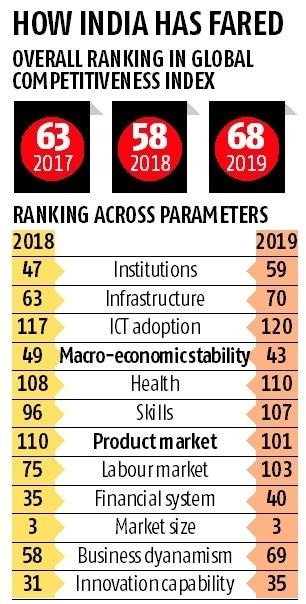Global Competitiveness Index 4.0: WEF | 10 Oct 2019
The World Economic Forum (WEF) has released the 2019 edition of the Global Competitiveness Report which features the Global Competitiveness Index 4.0 (GCI 4.0).
- The World Economic Forum introduced the new Global Competitiveness Index 4.0 in 2018. GCI 4.0 provides a detailed map of the factors and attributes that drive productivity, growth and human development in the era of the Fourth Industrial Revolution.
- The GCI 4.0 covers 141 economies, which account for 99% of the world’s GDP.
- The GCI 4.0 of 2019 reveal that, on average, most economies continue to be far from the competitiveness “frontier”—the aggregate ideal across all factors of competitiveness.
- A country’s performance on the overall GCI is reported as a ‘progress score’ on a 0-to-100 scale, where 100 represents the ‘frontier’, an ideal state where an issue ceases to be a constraint to productivity growth.
- This edition of the report focuses on building shared prosperity (addressing inequality) and managing the transition to a sustainable economy (addressing environmental issues) along with competitiveness and growth.
- The report is based on 12 set of factors (pillars) that determine productivity. These are: Institutions; Infrastructure; ICT adoption; Macroeconomic stability; Health; Skills; Product market; Labour market; Financial system; Market size; Business dynamism; and Innovation capability.
- The index has been an annual edition since 1979.
Key Findings
- India has moved down 10 places to the rank of 68th compared to the 58th rank of 2018 primarily because of faster improvements of several countries previously ranked lower.
- Positives for India:
- India ranks high on macroeconomic stability (90, 43rd) and market size (93.7, 3rd),
- India performs well when it comes to innovation (50.9, 35th), well ahead of most emerging economies and on par with several advanced economies.
- Its financial sector (69.5, 40th) is relatively deep and stable.
- Challenges for India:
- India ranks beyond 100th on five pillars and features in the top 50 of just four pillars.
- Major shortcomings in some of the basic enablers of competitiveness, like ICT adoption is limited (31.1, 120th) but has improved sharply (+8 since the 2017 edition).
- Health conditions remain poor, as reflected in low healthy life expectancy (59.4 years, 109th), which is one of the shortest outside Africa and significantly below the South Asian average.
- Weak banking system (60.4, 89th).
- India must also grow its skills base (50.5, 107th).
- Product market efficiency (50.4, 101st) is undermined by a lack of trade openness (43.9, 131st).
- The labour market is characterized by a lack of worker rights’ protections, insufficiently developed active labour market policies and critically low participation of women (ratio of female workers to male workers of 0.26, 128th)
- In South Asia, Sri Lanka is the most improved country in the region at 84th, Bangladesh (105th), Nepal (108th) and Pakistan (110th).
- China (28th) is the best performer among the BRICS countries.
- The Russian Federation ranks 43rd, South Africa is 60th, India is 68th and Brazil is ranked 71st.
- Singapore has become the world's most competitive economy in 2019, pushing the US to second place.
- Hong Kong Special Administrative Region (SAR) is ranked 3rd, the Netherlands is 4th and Switzerland is ranked 5th in the index.
- Vietnam (67th) registered the highest improvement across the globe.
